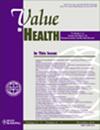美国转移性、顽固性或复发性宫颈癌患者接受阿特珠单抗加贝伐单抗和化疗的一线治疗:成本效益分析》。
IF 4.9
2区 医学
Q1 ECONOMICS
引用次数: 0
摘要
研究目的BETAcc 临床试验表明,化疗联合贝伐珠单抗加阿替珠单抗(CBA)可明显延长转移性、顽固性或复发性宫颈癌患者的无进展生存期(PFS)和总生存期(OS)。然而,据我们所知,将这种新疗法用于该适应症的经济价值目前尚不清楚。因此,我们的研究旨在从美国医疗支付方的角度评估 CBA 用于转移性、持续性或复发性宫颈癌一线治疗的成本效益:方法:我们建立了一个为期 10 年的状态转换马尔可夫模型,以比较 CBA 与化疗加贝伐单抗(CB)的成本和有效性。研究的主要结果包括成本、质量调整生命年(QALYs)和增量成本效益比(ICERs)。为了评估结果的稳健性,我们进行了单向敏感性分析和概率敏感性分析:与 CB 相比,CBA 额外增加了 0.58 QALY,额外成本为 172495.90 美元。ICER为295,972.43美元/QALY,明显高于支付意愿(WTP)阈值150,000美元/QALY。单向敏感性分析显示,研究结果对PFD效用、阿替佐珠单抗的单位成本和PD效用最为敏感。概率敏感性分析表明,在 150,000 美元/QALY 临界值下,CBA 获得成本效益的概率为 4.3%。要达到成本效益,阿特珠单抗的单价必须降低约56.6%:结论:在美国,与 CB 相比,CBA 治疗对持续性、复发性或转移性宫颈癌患者不太可能具有成本效益。本文章由计算机程序翻译,如有差异,请以英文原文为准。
First-Line Treatment With Atezolizumab Plus Bevacizumab and Chemotherapy for US Patients With Metastatic, Persistent, or Recurrent Cervical Cancer: A Cost-Effectiveness Analysis
Objectives
The BETAcc clinical trial demonstrated that chemotherapy combined with bevacizumab plus atezolizumab (CBA) significantly prolonged progression-free survival and overall survival in patients with metastatic, persistent, or recurrent cervical cancer. However, to the best of our knowledge, the economic value of using this new therapy for this indication is currently unknown. Therefore, our study aimed to evaluate the cost-effectiveness of CBA for the first-line treatment of metastatic, persistent, or recurrent cervical cancer from the United States healthcare payers perspective.
Methods
A state-transition Markov model over a 10-year lifetime horizon was developed to compare the cost and effectiveness of CBA with that of chemotherapy plus bevacizumab (CB). The primary outcomes of our study included costs, quality-adjusted life-years (QALYs), and incremental cost-effectiveness ratios. One-way sensitivity analysis and probabilistic sensitivity analysis were performed to assess the robustness of the results.
Results
CBA was associated with an additional 0.58 QALY at an extra cost of $172 495.90 compared with CB. The incremental cost-effectiveness ratio was $295 972.43/QALY, significantly higher than the willingness-to-pay threshold value of $150 000/QALY. One-way sensitivity analyses revealed that results were most sensitive to the progression-free disease utility, the unit cost of atezolizumab, and progressed disease utility. Probabilistic sensitivity analysis indicated that CBA achieved a 4.3% probability of cost-effectiveness at a $150 000/QALY threshold. To achieve cost-effectiveness, the unit price of atezolizumab must be reduced by approximately 56.6%.
Conclusions
CBA treatment is unlikely to be a cost-effective option compared with CB for patients with persistent, recurrent, or metastatic cervical cancer in the United States.
求助全文
通过发布文献求助,成功后即可免费获取论文全文。
去求助
来源期刊

Value in Health
医学-卫生保健
CiteScore
6.90
自引率
6.70%
发文量
3064
审稿时长
3-8 weeks
期刊介绍:
Value in Health contains original research articles for pharmacoeconomics, health economics, and outcomes research (clinical, economic, and patient-reported outcomes/preference-based research), as well as conceptual and health policy articles that provide valuable information for health care decision-makers as well as the research community. As the official journal of ISPOR, Value in Health provides a forum for researchers, as well as health care decision-makers to translate outcomes research into health care decisions.
 求助内容:
求助内容: 应助结果提醒方式:
应助结果提醒方式:


